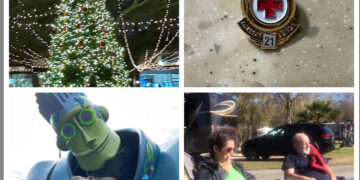Fulks Run is full of talent. Deep in the little town, with an amazing view of the mountains, and where wildlife abounds, sits an unassuming, old red barn.
This barn houses the Hollow Road Guitar Shop, workshop of luthier, Chuck DeHart.
What is a luthier? By definition, it comes from the French word for lute, a stringed instrument- a luthier is a craftsperson who creates or repairs stringed instruments.
Chuck DeHart creates museum quality pieces of art in the form of a guitar, turning simple pieces of wood into something amazing and magical, with a bit of whimsy thrown in.
He was born in Japan, into an Air Force family, one of 7 children, living many places while growing up. Chuck started playing the guitar in the ‘70s on a less than stellar instrument. He found an apprentice guitar making program in Washington state, that had a tutorial program 2 nights a week, near where he lived in Seattle. His path to designing and creating guitars was set. Living in Fulks Run since July of 1992, Chuck is now a retired JMU Senior Analyst , who he feels blessed to find some time for creating.
Chuck and his wife, Carol, live on a picturesque property off the beaten path. Inside a partially renovated old milking barn, is Chuck’s workshop, where all the magic begins.
The area where cows used to enter to be milked, has been redone to house the machinery needed for his craft. A small humidity and temperature controlled room holds his guitars, wood pieces, and a work bench. The best level is to keep the humidity between 45% and 55%. An oil radiant heater, steam humidifier, and an air conditioner, are carefully monitored, controlling the temperature and humidity throughout the changing seasons. The barn attic has his blank forms artfully displayed.
Sitka spruce, curly maple, black cherry, East Indian rosewood, poplar, persimmon, and mahogany, are just a few of the woods used to create his guitars. Some are sourced locally, some off his own property, and others from trusted vendors.
Tiny details like the binding, repurposed antique ivory piano keys for custom made fret markers, a 48 piece intricately made marquetry rosette, are just some of the things that earmark a DeHart creation.
Although he has designed and built many guitars over the years, Chuck’s signature pieces are DragonHart and the companion Lady Sprite guitars. Both are museum quality creations, and in the right hands, create amazing sound. Along with the 3D dragon carving, DragonHart has a rosewood faceplate with scrimshaw, 3 colors of mother of pearl, and a red coral heart repurposed from an old charm bracelet. The dragon top was carved from a poplar tree felled from his front yard.
Chuck’s interest in creating these pieces began at the Northwest School of Instrument Design in 1980. His first study piece was an Appalachian lap dulcimer. Over a period of 40 years, Chuck has created a few mandolins, and many guitars, each taking a year or two to complete. He does not build to sell, but he does have one or two that he might consider selling, to make room for more creations. Chuck has, as he says, “the skillset to build electric or steel string or arch top”, and likes to keep those around to show what he can do.
He can only take 6 or 7 at a time to a show, and has displayed them most recently at an exhibit to show at the Shenandoah Valley ArtFest in Woodstock.
For the right musician, the new jumbo Christian themed guitar Chuck made is unique and one of a kind, with religious symbols etched on repurposed ivory piano keys. It is both painstaking and time-consuming work, but he loves it.
He throws around words like marquetry rosette, rosette logs, planks, binding, book matched, purflings, that he was able to explain easily to the listener.
Chuck can tell you where each piece of wood in his shop is from, and when he found it. He recently used a $1.40 piece of redwood purchased 40 years ago, in Seattle. It was waiting for the just the right instrument to be used on. He has 40 year old spruce wood, air dried, from Seattle, waiting to be used. His veneers are sourced from online catalogs. Local hardwoods he has cut himself or have been given to him by friends are stacked and waiting. A Persimmon tree from his own property was recently used in his last arch top guitar for the bridge and fingerboard.
As far as making these guitars, this artist declares “There is a strategy, the art side, the skillset side, but I really don’t want to be in business – that would take the fun out of it.”
He can be found on Facebook, with links to his blog and website. You can read about his process, and where he might show up next to display his guitars and play a little music.
Facebook – Dragon Heart



































